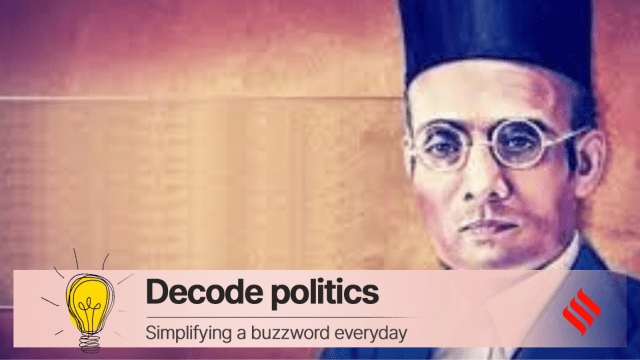Decode Politics: SC rejects plea to include Savarkar name in Emblems Act. What is this Act
The legislation preventing “the improper use of certain emblems and names for professional and commercial purposes” includes names of PMs, Nehru, Gandhi, Indira and Shivaji
 The Supreme Court dismissed a plea seeking a direction to the Centre to include the name of Vinayak Damodar Savarkar in the list of a 1950 Act. (Express)
The Supreme Court dismissed a plea seeking a direction to the Centre to include the name of Vinayak Damodar Savarkar in the list of a 1950 Act. (Express) The Supreme Court on Tuesday dismissed a plea seeking a direction to the Centre to include the name of Vinayak Damodar Savarkar in the list of a 1950 Act meant to prevent improper use of certain emblems and names for professional and commercial purposes.
The petitioner, who was appearing in person, told the Bench that he had been researching Savarkar for 30 years, adding: “I want to request the Court to issue directions to respondent number two (Union of India) and respondent number three (Ministry of Home Affairs) to include his name in the Schedule to the Emblems and Names (Prevention of Improper Use) Act, 1950.”
What is the 1950 Emblems and Names Act?
The Act prevents “the improper use of certain emblems and names for professional and commercial purposes”, which are listed in a Schedule adjoining the legislation. The Schedule can be altered by the Central government through a notification in the Official Gazette.
The Act mandates that “no person shall, except in such cases and under such conditions as may be prescribed by the Central Government, use, or continue to use, for the purpose of any trade, business, calling or profession, or in the title of any patent, or in any trade mark or design, any name or emblem specified” in the Act’s Schedule.
“Any colourable imitation without the previous permission of the Central Government” is also prohibited.
Besides, the Act prohibits the registration of any company, firm or other body from registering a trademark or design which bears any emblem or name that finds a place in the Schedule. A patent which bears a title containing any emblem or name of the mentions in the Schedule is also prohibited.
Any person who contravenes the provisions is punishable with fine.
What are the names or emblems mentioned in the Schedule
As per the Act, the name, emblem or official seal of the United Nations, the name, emblem or official seal of the World Health Organisation,”The Indian National Flag, and the official Government of India seal cannot be utilised for professional and commercial purposes.
The name, emblem or seal of the President, or any pictorial representation of the Rashtrapati Bhavan also finds place in the Act.
Certain freedom fighters and historical figures are not available for commercial usage. These include the name or pictorial representation of Mahatma Gandhi, former Prime Minister Indira Gandhi, Chatrapati Shivaji Maharaj, the Prime Minister of India. The words ‘Gandhi’ ‘Nehru’ or ‘Shivaji’, are not permitted except for pictorial use on calendars.
Even in the case of calendars, only the name of the manufacturers and printers of the calendars are to be mentioned and they should not be used for advertising goods.
The medals, badges or decorations instituted by the Government from time to time also find a mention.
The word “Interpol” which is an integral part of the International Criminal Police Organisation is part of the Schedule.
Certain other organisations find their place in the Schedule, such as the Tuberculosis Association of India, the St. John’s Ambulance Association (India), the Ramakrishna Math, the Sharada Math, and the Bharat Scouts and Guides, among others.
The name and emblem of Auroville, the town in Pondicherry, also falls under the purview of the Act.
What are some recent additions to the Schedule?
In 2004, the Sri Sathya Sai Central Trust founded by Sathya Sai Baba and the National Human Rights Commission were included among organisations use of whose name or emblem is prohibited.
In 2013, the name and emblem of the Federation Internationale de Football Association (FIFA) were added to the list.
How have the Courts reacted to it previously?
A key Supreme Court judgement 2004 answered “whether the right to fly the National Flag” by an Indian citizen is a fundamental right within the meaning of Article 19(1)(a) of the Constitution of India.
Industrialist Naveen Jindal had filed a writ petition on the subject in the Madhya Pradesh High Court, after a Jindal group factory in Raigarh was prohibited from flying the National Flag at the office premises of his factory as per The Flag Code of India.
The High Court allowed the petition and held the Flag Code of India was not a valid restriction on the right to freedom of expression under Article 19 of the Constitution. The Union of India filed an appeal against this decision to the Supreme Court, saying the decision on citizens being free to fly the national flag was not subject to court interference.
The SC found no merit in the Union’s appeal and ruled that the right to fly the National Flag freely with respect and dignity is a fundamental right of a citizen within the “meaning of Article 19(1) (a) of the Constitution of India — which is “being an expression and manifestation of his allegiance and feelings and sentiments of pride for the nation. However, it qualified that the fundamental right to fly the “flag is not an absolute right but a qualified one being subject to reasonable restrictions under clause 2 of Article 19 of the Constitution of India, The Emblems and Names (Prevention of Improper Use) Act, 1950, and the Prevention of Insults to National Honour Act, 1971, regulate the use of the National Flag”.
- 01
- 02
- 03
- 04
- 05































